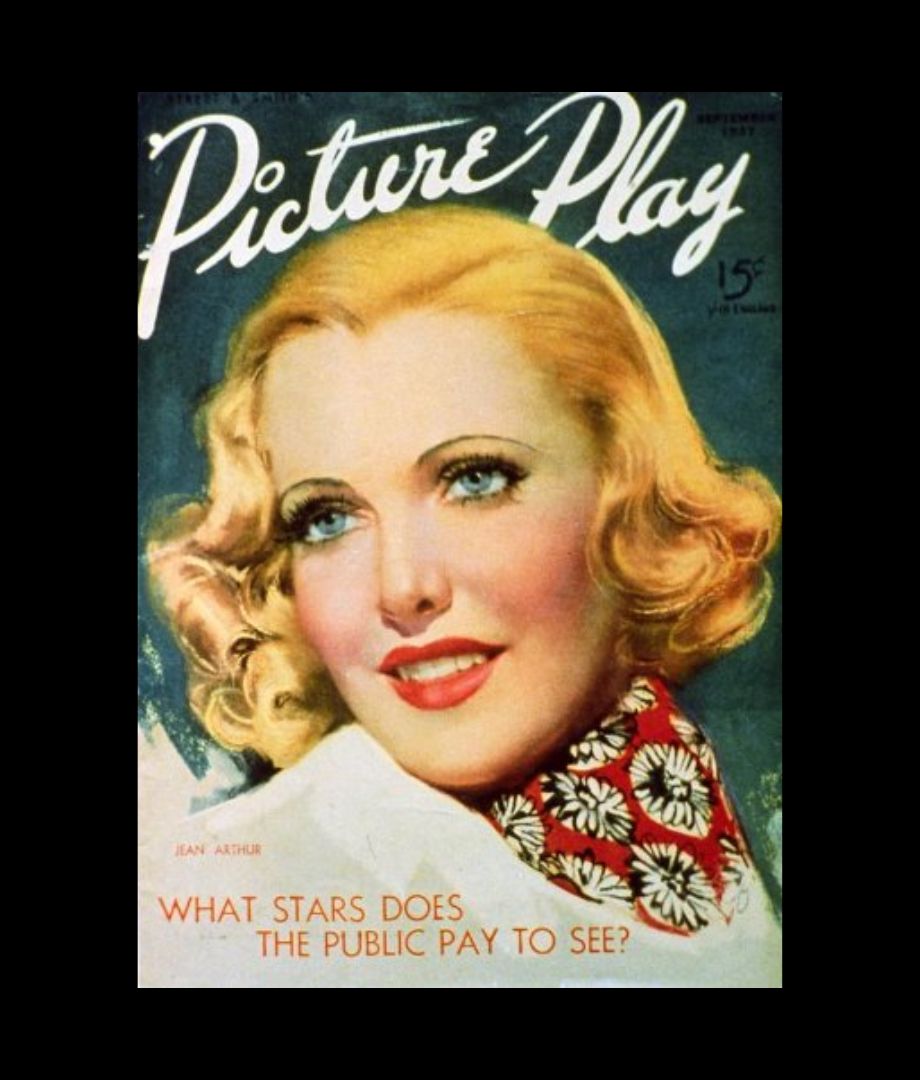Introduction
Jean Arthur’s face symbolizes Hollywood’s Golden Age—her charm, wit, and quiet rebellion shining through. Beneath a gentle smile and sparkling eyes lay a contradiction: a star who dazzled on-screen yet preferred obscurity off it. This duality continues to intrigue collectors who seek vintage magazine covers and articles that capture the magic and mystery of a woman fiercely protective of her privacy.
Unlike many contemporaries who embraced Hollywood’s limelight, Arthur let her films speak for her. She crafted characters that felt authentic and relatable, never distant. Fans came to know her not as an unreachable idol, but as the woman next door who could outwit the leading man or melt hearts with vulnerability. Vintage magazines serve as rare portals to understanding Jean Arthur’s elusive persona—snapshots of a star who revealed more through her work than her words.

Jean Arthur’s Enduring Legacy
In 1930s Hollywood—an era of grand premieres and luminous stars—Jean Arthur stood apart. She wasn’t interested in the social whirl that defined many careers. Instead, she focused on her craft. Though her start in silent films was unremarkable, sound cinema finally revealed the quality that would set her apart: that husky, distinctive voice. It gave her a signature presence that elevated the everyday woman into an endearing, intelligent heroine. With Babe Bennett in Mr. Deeds Goes to Town (1936), her career caught fire.
Audiences loved her because her characters were humorous, flawed, and intelligent—women you could relate to, not just admire from afar. By the time she starred in You Can’t Take It with You (1938) and Mr. Smith Goes to Washington (1939), she was a household name. Yet as her fame grew, she remained private, retreating from public events and press coverage. Fan magazines helped bridge this gap, keeping her accessible even when she chose not to be.
The Role of Fan Magazines in Preserving Her Image
In the 1930s and ’40s, fan magazines offered moviegoers glimpses into the lives of stars who otherwise remained distant. For someone like Jean Arthur, who rarely granted interviews or appeared publicly, these magazines were essential in shaping her public image. Pages of Picture Play or Silver Screen featured her warm smile, hinting at wit and approachability. She wasn’t the type to overshare or feed the gossip machine. This scarcity made every cover and article feel special—moments to savor and collect.
Collectors today treasure these vintage issues not merely for their age or her beauty, but for the connection they offer to a star who was both celebrated and guarded. Through these magazines, fans piece together the puzzle of a woman who let her films, rather than her personal life, define her legacy.
Jean Arthur: A Hollywood Icon
Arthur’s journey from silent film roles to the sparkling era of screwball comedies wasn’t easy or immediate. Her early years were unremarkable; she struggled to find parts that suited her subtler qualities in an industry craving glamorous bombshells. Still, she persisted. The advent of sound films turned what others saw as a disadvantage—her raspy voice—into a defining asset.
By the mid-1930s, she found her cinematic voice and, with it, stardom. In Capra’s films, she became the quintessential working heroine: intelligent, kind, and always grounded. Her success in the late ’30s and early ’40s solidified her as a beloved actress who redefined what a leading lady could be. Yet she remained an enigma: absent from parties, uninterested in fame’s trappings. Fan magazines, while never fully unveiling her mysteries, still offered a window to her world.
The Appeal of Jean Arthur in Vintage Magazines
Seeing Jean Arthur’s face on a vintage magazine cover is more than an aesthetic pleasure—it’s a direct link to a time when she reshaped the idea of a leading lady. She didn’t rely on scandal or glamour to captivate; rather, she won hearts by appearing genuinely human. Editors spotlighted her intelligence and authenticity, often discussing her roles rather than her private life. Through these covers and articles, fans perceived her as a woman who brought warmth, humor, and depth to the silver screen.
Key Vintage Magazines Featuring Jean Arthur
Certain magazine issues stand out as collectibles. Romantic Movie Stories (November 1936) aligns with her breakthrough in Mr. Deeds Goes to Town, showcasing her alongside Gary Cooper. Picture Play (September 1937) captures her after she excelled in Easy Living, while Silver Screen (August 1939) highlights her work in Mr. Smith Goes to Washington. These editions, tied to career-defining moments, remain especially cherished. Condition, rarity, and the significance of the roles featured all influence their collectible value.
Price Trends and Market Insights
The market for Jean Arthur memorabilia, including vintage magazines, reflects a blend of nostalgia, rarity, and timeless appeal. Issues connected to her iconic roles command higher prices. Pristine editions from the 1930s can range into the hundreds of dollars, while autographs, posters, and personal letters—due to her private nature—can fetch much more. Condition, provenance, and the magazine’s tie to a key film determine collectible value.
Other Jean Arthur Collectibles
Beyond magazines, posters, film stills, and autographs provide further windows into Arthur’s world. Original posters from films like Mr. Deeds Goes to Town or Mr. Smith Goes to Washington can sell for thousands, while autographs are precious due to her reluctance to engage in public fanfare. Auction highlights include personal letters and costume sketches, all offering collectors a tangible piece of cinematic history.
Why Jean Arthur’s Memorabilia Remains Relevant
Decades after her last film, Jean Arthur’s influence endures. Modern audiences rediscover her roles and appreciate how she shaped portrayals of strong, intelligent women on screen. Collectors find emotional connections through these artifacts, whether magazines, posters, or letters, each one a preserved moment in time.
Her legacy persists because her performances transcend eras. She exemplified independent, relatable heroines who resonate today. Holding a vintage magazine or film still isn’t just collecting—it’s reliving a golden moment in Hollywood and connecting with the subtle brilliance of Jean Arthur.

Conclusion
Jean Arthur’s legacy lives on through the collectibles that celebrate her. Vintage magazines, once newsstand staples, now serve as portals to a time when her quiet grace and genuine warmth captured hearts. Collectors value these items for their historical significance and emotional resonance. In each page, autograph, and photograph, Jean Arthur remains timeless—an enduring star who left an unmistakable imprint on cinema and those who cherish it.

